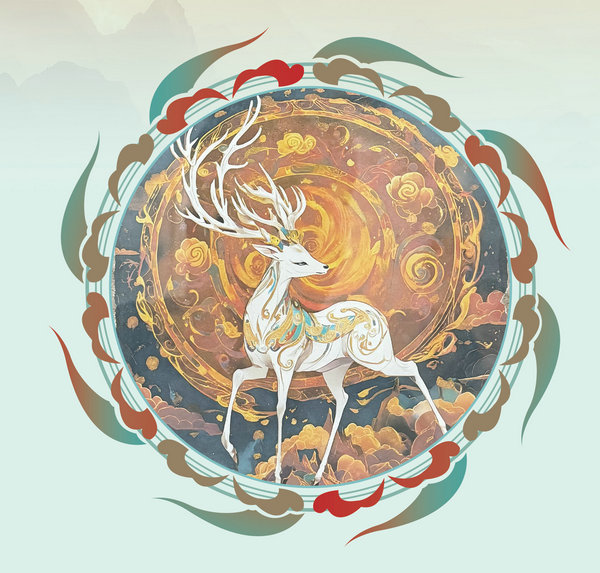From passersby to residents
A new generation of young entrepreneurs and cultural enthusiasts are revitalizing Dunhuang by blending its rich historical heritage with modern innovation and global connections.

A clay-board artwork inspired by the mural of A Deer of Nine Colors from the Mogao Caves of Dunhuang, created by Wu Mingfei using AI tools. [Photo provided to China Daily]
At the age of 10, Wu Mingfei received a gift from his mother: a thick book about the murals in the Mogao Caves of Dunhuang, Northwest China's Gansu province. This gift ignited his passion for painting and inspired his dream of visiting the caves one day.
In 2017, Wu, originally from Sichuan in Southwest China, finally made the trip to Dunhuang.
"The murals were even more stunning than what I had seen in the book. That was when I knew I wanted to stay here," he said.

Wu Mingfei, a painter in Dunhuang. [Photo provided to China Daily]
Now 32, Wu runs an art studio in Dunhuang, where he recreates the murals on clay boards to capture their texture and essence. This allows visitors to take home a piece of the mural experience.
"Only a few caves are open to tourists due to conservation concerns, and they can't take photos or stay inside for long," Wu explained.
According to him, the Dunhuang murals are famous for their vivid colors, achieved using natural mineral pigments that have preserved their brilliance for centuries.
However, due to their high cost, Wu primarily uses regular paint for his market pieces, but he also showcases works made with mineral-based pigments in his studio and at exhibitions, offering visitors an authentic glimpse of traditional Dunhuang art.
One of his most popular pieces is A Deer of Nine Colors, a mural from Cave 257, dating back to the Northern Wei Dynasty (386-534).The story, later adapted into an animated film in 1981, follows a nine-colored deer that saves a merchant from drowning, only to be betrayed by him. In the end, the merchant faces the consequences of his dishonesty.

Olga Pronkina, a Russian professor of Dunhuangology at Gansu University of Political Science and Law. [Photo provided to China Daily]
This mural has not only influenced generations of Chinese children but also deeply resonated with Olga Pronkina, a 38-year-old Russian professor of Dunhuangology at Gansu University of Political Science and Law in Lanzhou.
In 2009, Pronkina moved to Lanzhou, where she worked in Russian language education and translation.
In 2015, she began translating books on Dunhuang, which gave her the chance to visit the region and encounter the mural of the nine-colored deer in the Mogao Caves.
She was astonished to find its striking resemblance to The Golden Antelope (1954), a Russian animated film she had watched as a child.
This unexpected cultural connection, bridging both time and geography, left her profoundly impressed.
"That's when I realized I had already been exposed to Dunhuang art; I just hadn't recognized it at the time," she said.
As a lifelong enthusiast of geography and history, Pronkina noticed that Dunhuang was rarely included in the middle school curricula of Russian-speaking countries.
"Dunhuang, situated at a key crossroads, historically connected the five Central Asian countries, once known as Xiyu (western regions) in ancient China. I want to bring this historical treasure back into the spotlight," she said.
Over the years, Pronkina has actively shared the story of Dunhuang with young audiences in Russian-speaking countries, from middle school students to university scholars.
"I believe the future of Dunhuang's culture lies with the youth, who may become the next generation of researchers in this field," she said.





 Print
Print Mail
Mail
